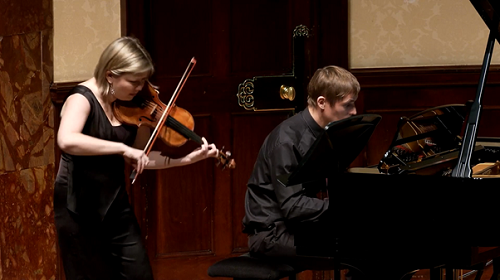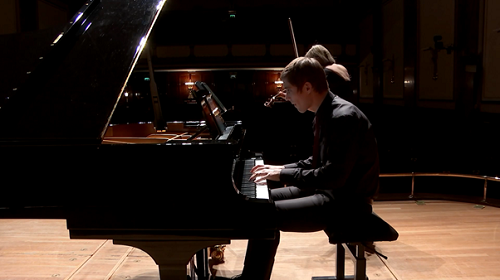 United Kingdom Mendelssohn, Prokofiev, Franck: Alina Ibragimova (violin), Cédric Tiberghien (piano). Wigmore Hall, London, recorded live and streamed on 19.1.2021. (CS)
United Kingdom Mendelssohn, Prokofiev, Franck: Alina Ibragimova (violin), Cédric Tiberghien (piano). Wigmore Hall, London, recorded live and streamed on 19.1.2021. (CS)
Mendelssohn – Violin Sonata in F
Prokofiev – Five Melodies Op.35bis
Franck – Sonata in A for violin and piano
Back in June, during Wigmore Hall’s wonderful spring-summer series of streamed recitals, I greatly enjoyed the performance of sonatas by Schubert and Beethoven given by Alina Ibragimova and Kristian Bezuidenhout. Now, during yet another lockdown, Ibragimova returned to the Hall with her habitual musical partner Cédric Tiberghien to inject a little more sunshine into this dark and miserable January, in a recital made more poignant and precious by the news that, in response to the current state of the pandemic, Wigmore Hall has taken the decision to pause its broadcasts from early February.
It’s hard to think of a sunnier musical moment than the opening of the final movement of César Franck’s Violin Sonata, which was written in 1886 as a wedding present for the violinist Eugène Ysaÿe. And, it’s hard to think of two musicians whom I’d prefer to hear play it than Ibragimova and Tiberghien whose recording of the Sonata for Hyperion was universally lauded. The languid tempo, the soft warmth of the piano’s gentle opening gestures and the flexibility of the violin’s phrases were instantly mesmerising. I could feel every muscle in my body relax, as if I were floating in warm water enriched with heady perfumes. Playing with unwavering lyricism, elegance and subtlety, Ibragimova employed a light tone that nevertheless had compelling focus. The duo resisted the temptation, too often indulged, to inject too much urgency, permitting just enough expanse to hint at things to come.

Similarly, the Allegro molto was not a headlong rush, as is sometimes the case, but rather an expressive journey which surged and withdrew compellingly. The clarity of Tiberghien’s quicksilver passagework, and the lightness of the pedalling, were startling; for once I could hear the swinging bass line which, like a pendulum, propels the music forwards. Ibragimova let her bow do the work in creating fullness and richness of tone: her vibrato was even, and well-judged, never too much. There was a wonderful poise in the more introverted episodes, followed by the exciting release of the piano’s tumult and the impassioned rhetoric of the violin – I loved the way Ibragimova took her time cresting the peaks of the violin’s soaring ascents. Never did the music run away with itself; all was effortlessly controlled. The cleanness of Ibragimova’s finger-work and string-crossings in the violin’s accompanying semiquaver passages was impressive. I felt myself take an intake of breath as the duo took off impetuously into the final accelerating sprint, and the final low, resolving A was brief – an assertive gesture of assurance and fulfilment.
Tiberghien began the Recitativo-Fantasia in similar forthright fashion, but the violin’s finely shaped roving tapered away to the sweetest of pianissimos which evaporated into silence. Tempo and structure were once again perfectly judged. And, at the close Ibragimova made me hear the major-minor inflections completely anew: the close seemed darker, more intense, more dangerous. But, the clouds vanished instantly when, with crystalline simplicity, the canonic melody of the Allegretto poco mosso commenced its joyful journey. This was such beautiful playing that the only disappointment was that the movement seemed over far too quickly.
The recital had begun with the teenage Mendelssohn’s Violin Sonata in F. Written in 1825, the Sonata was partially revised thirteen years later, but left unpublished by the composer. It was rediscovered in the 1950s by Yehudi Menuhin, who fashioned a new edition from the two versions, but the Sonata has not attracted much interest among the violin-playing fraternity. Recalling Menuhin’s effusive account of the work, which he judged possessed “the chivalrous Romantic quality of the age that produced Schumann”, BBC presenter Kate Romano offered her own somewhat florid description of the work: “tightly knit, concerto-like … bracingly virtuosic … with textures one can imagine spread across an orchestra”. Mendelssohn himself thought it was “wretched”. Certainly, the Sonata does not reach the creative heights of the Op.20 String Octet that was also composed in 1825, but it is a happy, melodious work for which the ‘equal partner’ relationship of Beethoven’s violin and piano sonatas seems the most obvious model.

Ibragimova and Tiberghien relished the vibrancy of this chamber music. The brilliance of the opening was arresting, both the piano, which presents the first assertive statement of the main theme, and the violin filling the Hall with shining tone. The duo achieved a judicious balance between impassioned Romanticism and elegant lyricism. Ibragimova’s relaxed bowing action in the second subject flowed persuasively, producing a heartfelt song, never forced but always free. Its inner energy diffused into vigorous rising scales culminating in the rapturous reprise of the main theme, the leaping motifs of which recall the youthful joy of the Italian Symphony. A beautiful glow warmed the forte E-string passages, but in the minor key development section Ibragimova conjured a quieter intensity, building the tension through the repeating motifs towards the release of the recapitulation which was impassioned but never thunderous.
The piano’s low melody infused the opening of the Adagio with a delicate melancholy, while sensitive emphasis hinted at hidden depths of feeling. Relaxed, but with momentum, the right-hand triplets trickled beneath the violin’s melody – the latter the epitome of simple directness and sincerity. Surprising passion burst forth at times, as if a gusty wind had suddenly whipped up a clear lake’s still waters, but such outbursts were quickly quelled. The high-spirited Allegro assai – Mendelssohn at his most mischievous – raced forwards with astonishing crisp incisiveness from both musicians. Pianissimos made one hold one’s breath, cheeky fortes brought a smile to one’s face. The scurrying never pressed too hard, and the music dashed to the finish line with a light spirit and fleet foot – and sometimes on tiptoe.

100 years after the sixteen-year-old Mendelssohn penned his Sonata, Prokofiev – with the assistance of Paweł Kochański – transcribed for violin and piano the Five Melodies that he had written in 1920 as vocalises for Nina Koshetz, the Ukrainian-born soprano who shortly after would create the role of Fata Morgana in The Love for Three Oranges. The first miniature had the dream-like chromatic slipperiness that one finds in the composer’s second Violin Sonata, a dreaminess which occasionally turned dark. The Lento ma non troppo had an easy melodiousness and silky sheen, with folky inflections energising the central Poco più mosso section. Passion, tranquillity and mystery were counterposed in the third Melody, but the air was refreshed in the insouciant Andantino. The final movement was both refined and full of character.
Lili Boulanger’s Nocturne from the 2 Pieces for Violin and Piano (1911) was a bitter-sweet encore, bringing down a veil of tender melancholy over this wonderful recital.
Claire Seymour
Six further concerts will be streamed from Wigmore Hall between 25 January and 8 February. Click here for details.